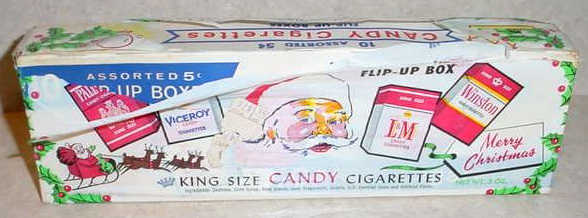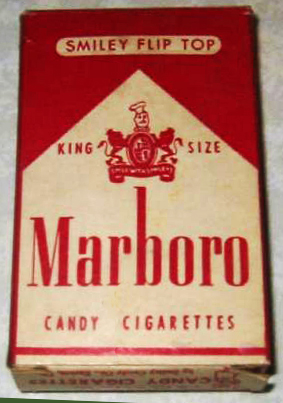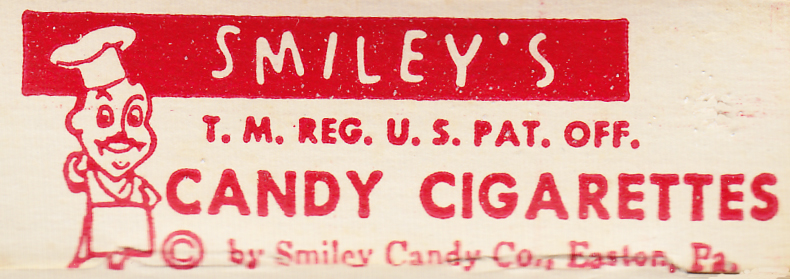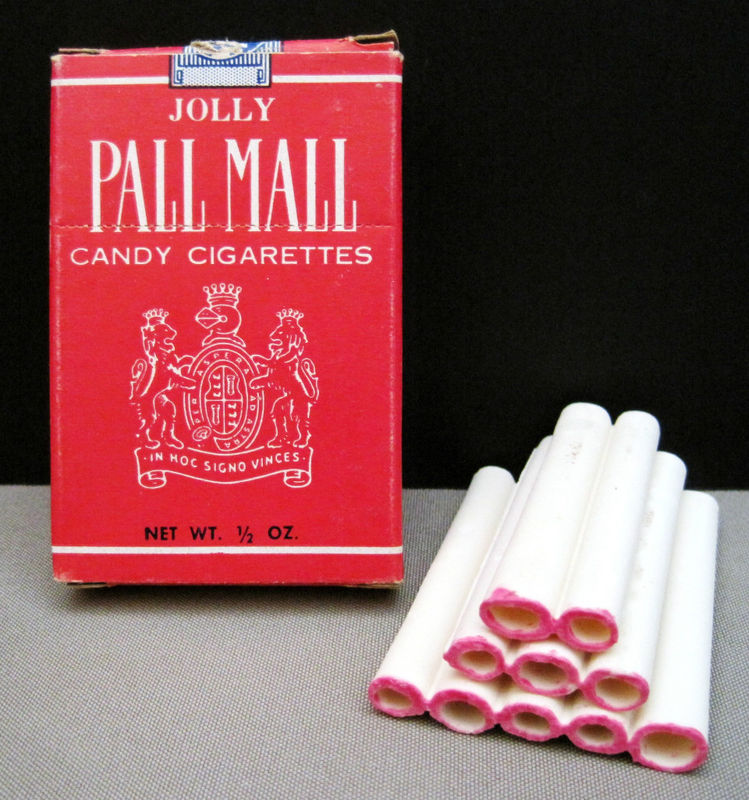|
Page A3 The Joan De Arc Crusader / Sunday, September 16, 2012 Front Page A1 / Editorials A2 / Crossword A4
The rise and fall of the candy cigarette By J. Bueker Seems a bit surreal now, but there was a time in the not-so-distant past when cigarettes made of candy were a well-loved and widely accepted childhood treat. Candy cigarettes were first manufactured in the early 20th century but remained something of an obscure novelty until the 1950s, when their popularity expanded enormously, probably due to the proliferation of cigarette commercials on TV. By mimicking the popular name brands of real cigarettes, the candy cigarette manufacturers could get all kinds of free advertising for their products. Decades later of course, Joe Camel would turn the tables and entice young people to smoke the real things. My own love
for the candy cigarette dates to the earliest reaches of my childhood. Years
before our family moved out west to Phoenix, I was imploring my mother to
purchase candy ciggies for me at the neighborhood Rexall store located just
around the corner from our sleepy little street in Livonia, MI. One of my
precious few memories of Christmas back east is the candy cigarette gift pack I
received on Christmas Eve, 1962. The holiday gift packs were quite the popular
item in the late ‘50s and early ‘60s, and I was plainly thrilled to receive one,
hence the enduring memory. Well it turns out that the best candy cigarettes of all were manufactured by a small candy company in Easton, Pennsylvania called Smiley’s. These particular candy smokes had a distinctly yummy flavor and unusually rough texture that set them apart from all the competition. Each box was adorned by an adorable little character named, naturally enough, Smiley, who resembled an overweight, middle-aged effeminate man with a moustache wearing a chef’s hat and apron. Okay, now that sounds a little odd in retrospect, but it seemed perfectly normal and even charming at the time. Cigarette TV commercials were ubiquitous by the early ‘60s and thus the most popular brand names became very familiar to everyone, including kids. Hell, especially kids. The familiar jingles became part and parcel of our playground discourse: “Winston tastes bad like the last one I had… No filter, no flavor, tastes like toilet paper!” Marlboro was the most popular cigarette brand (and no doubt remains so to this day), and so Smiley’s “Marboro” brand quickly emerged as my favorite candy cigarette of all time (trademark legalities prevented an accurate spelling of the name “Marlboro”). These were simply the coolest candy cigarettes, bar none. The pinnacle. Aside: I sometimes wonder whether the Marlboro Man himself ever had occasion to nibble on some candy cigarettes. Yes I know, that’s kind of a weird thing to contemplate, but hey, somebody needs to examine these ideas. By around the age of 7 or 8, I entertained a brief infatuation with a related candy-tobacco product, the bubble gum cigar. Yes, I was definitely becoming a more urbane young man, and candy cigarettes alone were no longer sufficient to convey my increasingly sophisticated self-image. One Sunday
afternoon in perhaps 1966, my mother announced a quick family trip to the
Chris-Town Walgreens for some reason, and here I saw my chance to at last
procure the coveted bubble gum stogie. The Walgreens at the mall was about the
only place I had ever seen them offered for sale. We arrived at Walgreens at around 4:57 pm that afternoon, and with great excitement and anticipation I immediately dashed off to the candy section of the store. As I stood there pondering whether I wanted a green bubble gum cigar or a yellow one, a store employee approached me and brusquely announced that the store was closing and my immediate departure would be required. We all walked out of the store without getting what we came for, my mother included. My bitter disappointment was extinguished the following weekend when we made a return trip to the mall, this time well before closing time at Walgreens. The bubble gum cigar tasted all the sweeter. Another alternative candy-tobacco treat with which I experimented for a time was the chocolate candy cigarette, packs of which we obtained at the Tang’s Imports store at Town and Country Shopping Center. These ciggies were certainly quite tasty, but unlike the standard candy cigarette, chocolate candy cigs had an unfortunate tendency to melt into chocolate sludge in the unforgiving Phoenix heat. I soon abandoned this chocolatey flirtation and returned to my trusty Smiley’s Marboros. So why were the candy cancer-sticks so popular? Well besides the fact that they were a uniquely tasty confection, candy ciggies conferred upon youngsters a genuine feeling of being a grown-up. The tips of the candy cigarette were customarily shaded red to simulate the glowing ember of an actual lighted smoke, a nice touch that certainly enhanced the overall effect. There was an undeniable mature worldliness associated with the candy cigarette that no other sweet treat of the day could offer a kid. Of course as the 1960s progressed, an awareness of the dangers of real cigarettes emerged and then rapidly coalesced in the public consciousness. In short order, the perception of candy cigarettes was transformed from that of a whimsical childhood delight to an unspeakably vile threat to the future of all mankind. The apparent
concern was that the acceptability of candy cigarettes would “desensitize”
youngsters to real cigarettes and facilitate the transition to full-blown
nicotine My father, who enjoyed the pleasures of tobacco smoke himself for quite a few years, was originally amused by my love for candy cigarettes. But as the cultural tide turned, he began to actively discourage my infatuation with the sugary little cylinders. Dad ultimately forbade me to purchase the things altogether, thinking this would mitigate my chances of using actual tobacco down the road. I never did quite get the connection between inhaling tobacco smoke and snacking on little sticks composed of dextrose, sugar, gelatin, and corn starch. But hey, he was the dad. Today, candy cigarettes continue to be manufactured by a handful of small companies, but they appear now as but a pitiful shadow of their former glory. Long gone are the days of the name brand candy ciggie, and even the words “candy cigarette” have been largely banished, replaced by less threatening terms like “candy sticks.” I mean, what is even the point anymore? “Say, look how cool I am, hanging out with my box of candy sticks.” Sad. I have assembled a small collection of old Smiley’s boxes that I found on ebay (where else?), some of which remain unopened with the fossilized candy cigarettes still residing inside. Sellers on ebay routinely advise against trying to eat the ancient candy cigarette remains, which leads me to speculate whether there really is a genuine hazard involved in consuming 50-year-old candy cigarettes. I’m guessing the things simply don’t taste too good anymore. I like to think that Carl Bueker would be proud that my long-standing love for candy cigarettes never did evolve into a tobacco smoking habit, although he might be a little disturbed by the fact that I’m still buying candy cigarettes in my fifties. ____________________________________________________________________________________________________________________ JDA
|



 addiction. Some even went so far as to suggest that candy cigarettes were an
evil plan formulated by the tobacco companies to ensnare the innocent youth of
America.
addiction. Some even went so far as to suggest that candy cigarettes were an
evil plan formulated by the tobacco companies to ensnare the innocent youth of
America.